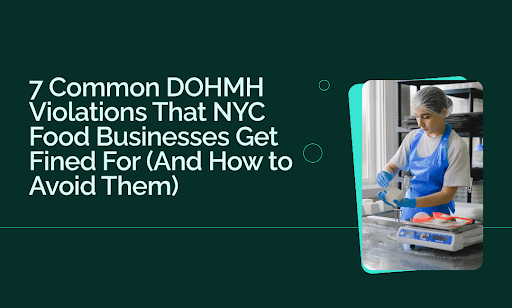You can pass a surprise inspection and still rack up fines six weeks later. Not because you stopped cleaning—but because the rules are more layered than they look.
DOHMH violations in NYC don’t always stem from roaches or rats. Often, it’s the small, overlooked habits that trigger big penalties. A hand sink without soap. Raw chicken is stored next to produce. Sanitizer spray near clean dishes.
These aren’t outliers. They’re patterns. And they’re costing food businesses thousands.
Here’s the good news: they’re avoidable. But only if you know what to look for—and how to track it before an inspector walks through your door.
In this article, we’ll break down:
- Why poor personal hygiene is a silent score-killer
- What “sanitized” really means in DOHMH terms
- How improper food storage gets flagged fast
- The time/temp slip-ups that trigger fines overnight
- Why where you place your utensils actually matters
- How chemical placement can shut you down in minutes
- What inspectors spot when cross-contamination happens
Then we’ll show you how to avoid every single one of these using ViolationWatch—without adding more to your plate. You’re not here to fight red tape. You’re here to run a clean, compliant kitchen. We’ll help you do that—smartly and proactively.
The Hygiene Violation That Slips Past Most Teams
You’ve trained your staff to wear gloves. You’ve posted hand-washing signs. So, why is personal hygiene still one of the most frequent DOHMH violations in NYC? Because hygiene infractions aren’t always about what’s visible. It’s not just about dirty hands or missing soap—it’s about protocol gaps that get flagged under close inspection.
The issue isn’t lack of effort. It’s an inconsistent execution—something every human operation is prone to without clear oversight.
What Inspectors Look for During Routine Checks
Most operators assume clean uniforms and glove use cover the hygiene box. That’s far from the full picture. Inspectors don’t just spot what’s missing—they spot what’s not being done consistently.
Here’s what actually triggers citations:
- Bare-hand contact with ready-to-eat foods: Even a split-second slip-up—like touching bread while assembling a sandwich—can trigger a violation.
- Missing or poorly stocked hand-washing stations: No soap? No paper towels? Blocked sink? That’s enough for a hygiene downgrade.
- Improper glove use: Wearing gloves but not changing them between raw and cooked food? That’s flagged. Every time.
- Personal items in food prep areas: Phones, keys, drinks, jackets—anything that doesn’t belong can be cited.
- Lack of documented hygiene policies: Verbal reminders aren’t enough. DOHMH wants to see written SOPs and training logs.
Being aware of what inspectors actually target is half the battle. The other half is ensuring your team follows protocols even when no one’s watching. Take this example: A line cook changes gloves between tasks but forgets to wash hands beforehand. That step—often skipped under pressure—results in a hygiene violation, even if everything else looks clean.
DOHMH doesn’t assess hygiene based on visible effort. It looks for patterns of enforcement. Additionally, they expect every shift to run with full compliance, not just during peak hours.
If your restaurant is part of an industry association or works closely with a food safety consultant, you likely already receive updates from the authority on new hygiene standards. But printed posters won’t protect your grade unless your team applies what they’ve learned.
Documented training logs help you obtain proof of compliance and demonstrate a complete hygiene policy during any surprise inspect. And in a competitive city where diners pay close attention to letter grades, one overlooked glove change can mean a lot more than a warning.
Why “Clean” Isn’t Always Considered Sanitized
Most kitchens clean surfaces every shift. Wipe-downs happen. Buckets get changed. But during inspections, “clean” doesn’t cut it unless it’s been sanitized to code.
The Department of Health has a clear definition of sanitization—and it’s far more specific than general cleaning. You could scrub a prep table until it shines and still earn a violation if the sanitizing process doesn’t meet DOHMH standards.
The DOHMH Sanitization Checklist
To meet code, sanitized means surfaces and tools have been treated in a way that kills bacteria, not just removes visible debris. Here’s what inspectors are trained to look for:
- Correct sanitizing agents in proper concentrations: Whether you’re using chlorine, quats, or iodine, the solution needs to be mixed within approved ranges. Too weak, and it’s ineffective. Too strong, and it’s unsafe.
- Approved test strips on hand: You must be able to test the sanitizing strength on the spot. If strips aren’t available—or expired—that’s a citation.
- Three-compartment sink usage: Wash. Rinse. Sanitize. Skip a step or mix up the order, and it’s logged as a procedural violation.
- Air-drying of equipment: Toweling off after sanitizing can reintroduce bacteria. Equipment must air dry on clean, elevated racks.
- Daily logbooks or labeled bottles: Clear labeling of chemicals and date-stamped logs shows consistency and training.
Where Most Teams Miss the Mark
The most common error isn’t forgetting to sanitize. It’s not doing it by the book. Sanitizer stored in unlabeled spray bottles. No test strips during inspection. Reused towels drying prep counters. These tiny missteps look minor—until they’re cited as hygiene risks.
Every surface that touches food—counters, slicers, cutting boards—must be sanitized and documented. That’s the standard. If your system can’t prove it’s happening correctly, inspectors assume it isn’t happening at all.
Where Food Storage Fails Trigger Fast Violations

Inspectors don’t need much time in your walk-in to spot a violation. They’re trained to scan for small indicators—unlabeled containers, uncovered items, food stored too close to the floor. These seem minor, but they get flagged immediately.
Storage rules in NYC go beyond basic food safety. They’re designed to prevent spoilage, contamination, and pest attraction at scale. If your setup isn’t structured or labeled with compliance in mind, you’re already at risk.
What Makes Storage Non-Compliant
Food storage violations usually fall into two buckets: how items are organized and where they’re placed.
Here’s what typically draws citations:
- Raw food stored above cooked or ready-to-eat items: Drips, leaks, or packaging damage can cross-contaminate. The hierarchy matters—and inspectors will check every shelf.
- Uncovered containers or pans: Open food is vulnerable to airborne contamination. Even in a closed fridge, it’s not protected without a proper cover.
- Food not labeled or dated: If it’s not labeled with name and prep date, it’s considered expired. This includes house sauces, marinades, chopped produce, and thawing proteins.
- Items stored directly on the floor: Every food item—raw, cooked, or sealed—must be at least six inches off the ground. Floor-level storage is an automatic deduction.
- Overloaded or disorganized fridges: If the air can’t circulate properly, your fridge can’t maintain temperature. That puts every item at risk, even if your thermometer says otherwise.
- Cross-use of containers: Using food packaging to store chemicals or vice versa is a red flag. Even clean, reused containers can lead to issues if not clearly labeled.
Cold Storage Needs Structure
Walk-ins often become chaotic during rush periods. But without a structured storage system, you’re one inspection away from multiple citations.
Set up designated shelves for:
- Raw proteins (lowest shelves)
- Washed produce
- Prepared items and ready-to-eat foods (highest shelves)
- Bulk dry goods
- Dairy and eggs
Use color-coded containers, laminated shelf labels, and daily checks to keep everything in order.
Ambient Storage Matters Too
It’s not just about the fridge. Inspectors also check ambient storage areas—dry goods, flour bins, oils, canned products.
Common missteps include:
- Items stored under plumbing lines
- Products kept near chemicals or cleaning supplies
- Open bins without lids
- Food stored in janitorial closets or under sinks
Each of these setups introduces contamination risk. Even if the food stays untouched, improper placement alone is enough to get cited.
When Time and Temperature Mistakes by Restaurant Owners Lead to Overnight Fines
Walk-ins can stay cold, thermometers can look normal—and you can still get hit with a Time/Temperature Control (TTC) violation. That’s because it’s not about the equipment. It’s about what the food actually reaches, and for how long.
DOHMH inspectors check the internal temperature of the food—not the air around it. And if any item falls outside the safe zone, it’s a fine. No exceptions.
The Temperature Danger Zones That Matter
There’s a specific range where bacteria grow fast—between 5°C (41°F / 314K) and 60°C (140°F / 333K). Food that stays in this range for over two hours is considered unsafe.
Here’s what’s flagged most often:
- Cold foods above 5°C (41°F / 314K): Even 6°C (43°F / 316K) is non-compliant. Measured inside the food—not the walk-in air.
- Hot foods below 60°C (140°F / 333K): Holding trays, steam tables, and buffet setups must maintain internal heat. If the center cools, it counts.
- Improper cooling practices: Hot food is placed directly in the fridge without using shallow pans or ice baths. That slows down cooling and increases risk.
- Thawing at room temperature: Proteins or sauces left out to defrost at ambient temperatures quickly breach the danger zone.
- No visible time logs or temperature checks: If your staff isn’t documenting when food was prepped, stored, or moved, there’s no proof of compliance.
Where the Fines Build Up
TTC issues usually come in groups. One cold item above the temperature? Inspectors often sample others in the same unit—and multiple fines follow.
Here are the usual triggers:
| Violation Type | Triggered By |
| Improper Cold Holding | Raw meat stored at 7°C (45°F / 318K) or higher |
| Improper Hot Holding | Cooked rice at 55°C (131°F / 328K) in a steam tray |
| Improper Cooling After Cooking | No ice bath used; large soup containers directly stored |
| Improper Reheating for Hot Hold | Food not reheated to 74°C (165°F / 338K) within 2 hours |
Preventing Violations Without Guesswork
Relying on visual checks or fridge settings doesn’t cut it. Staff must use calibrated thermometers to measure actual food temperature—and record that data regularly. Cooling logs, temp charts, labeled storage times—these are what make the difference between a clean inspection and multiple TTC fines.
You’re not expected to be perfect. But if time and temperature aren’t tracked tightly, fines pile up fast. Overnight.
How Poor Utensil Placement Gets You Penalized
DOHMH inspections go beyond how tools are cleaned—they zero in on how and where those tools are stored. A sanitized spatula used moments ago can still trigger a violation if it’s resting on a dirty prep table.
That’s the part most teams overlook. You’re not fined because the utensil is dirty. You’re fined because its placement creates the potential for contamination.
Inspectors Scan for Placement, Not Just Cleanliness
Utensils need to be stored in a way that protects them between uses. Not balanced on cutting boards. Not stashed in a corner sink.
Improper storage signals to inspectors that food contact surfaces aren’t being protected consistently. That’s a critical violation.
Here’s where utensil placement often breaks compliance:
- Storing utensils directly on food prep surfaces: Even if wiped down regularly, prep tables are considered high-risk for cross-contact.
- Leaving utensils submerged in standing water: If that water’s below 60°C (140°F / 333K), it becomes a bacterial breeding ground.
- Propping tongs, spoons, or knives in between equipment gaps: Dust, grease, and food residue collect in those crevices. That makes contact surfaces unsafe.
- Placing utensils inside ingredient bins or containers: Scoops and spoons must have dedicated holders outside the food bin—not buried in sugar, flour, or sauces.
- Improper storage at service stations: Coffee stirrers, ice scoops, garnish tongs—these often get left out or mixed with personal items like pens and order pads. That’s flagged.
What Counts as Proper Storage
To meet DOHMH expectations, utensils must be stored to protect them from dust, splashes, and hand contact between uses. That means:
- Clean containers, trays, or holders designated specifically for sanitized tools
- Elevation off work surfaces
- Separation between raw and ready-to-eat use items
- Regular replacement throughout the shift
Visual clarity matters too. If your staff can’t clearly identify which tools are clean, stored correctly, and ready for use, it means your system is too loose.
Break the Habit of “Temporary” Storage
One of the most common phrases during inspections? “I was going to move that.”
Tools left sitting between tasks may feel temporary, but inspectors document what they see in the moment. There’s no benefit of the doubt if a ladle is in the wrong spot or if a scoop is touching the handle of a garbage bin.
Utensil storage is one of the easiest violations to avoid—and one of the fastest to get flagged. Build better storage habits now, or risk repeat citations for details your staff doesn’t even notice.
Why Improper Chemical Placement Ends Service Fast
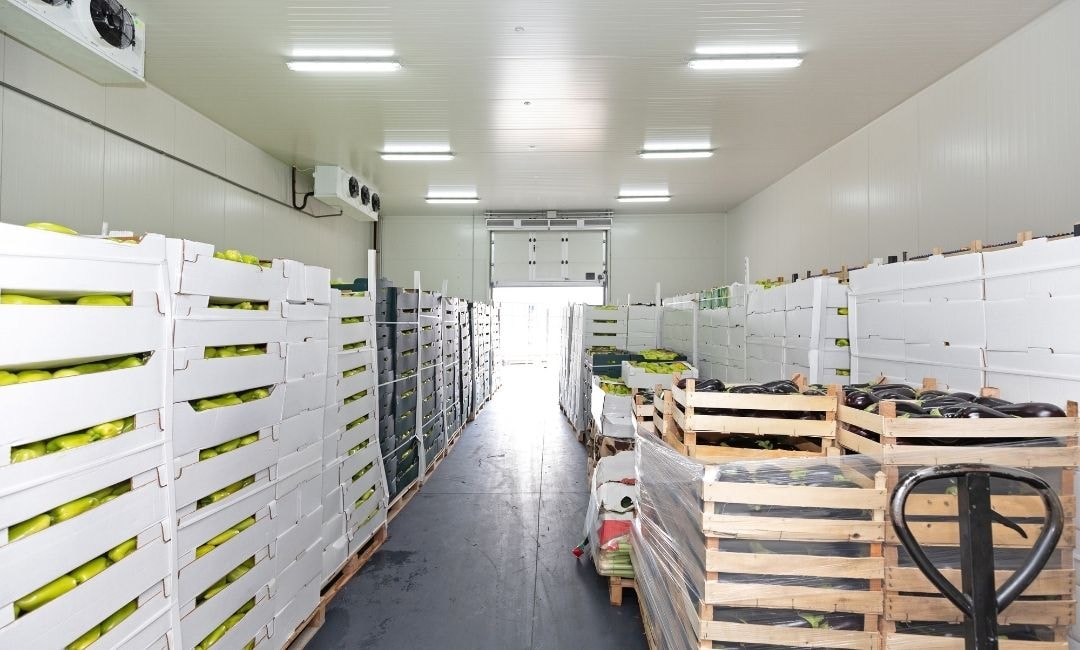
One misplaced spray bottle can turn a passing inspection into a forced closure. Chemical violations are treated as immediate hazards, not procedural issues. If cleaning agents are found anywhere near food, utensils, or prep surfaces, they shut you down.
The rule is simple: chemicals and food must stay completely separate—in storage, in transit, and during active service. Yet violations happen daily because staff assume it’s fine to leave sanitizer on the prep table or degreaser under the sink.
Where Chemical Violations Usually Happen
It’s not about whether the bottle is full or sealed. It’s about where it’s placed and how it’s labeled. Here’s what gets flagged most often:
- Unlabeled spray bottles near prep areas: If it’s not clearly marked with contents and dilution, it’s treated as an unknown hazard.
- Chemicals stored above food or food-contact surfaces: Even if the bottle never leaks, the potential for contamination is enough to earn a violation.
- Buckets of sanitizer stored under cutting boards or next to clean dishes: Sanitizer isn’t a problem—until it’s placed where runoff or splashing could reach food items.
- Pesticides or maintenance chemicals kept in food storage areas: Back-of-house areas like dry goods storage often double as utility closets. Inspectors won’t tolerate cross-use.
- Chemical containers stored near single-use items: Napkins, to-go containers, paper towels, and disposable gloves must be protected like food.
Preventing Cross-Contamination Risks with Chemicals
Build out dedicated storage areas for all cleaning products. Use locked cabinets or segregated utility shelving—never place chemicals in or near food storage zones.
Make sure every chemical is:
- Labeled clearly with name and use
- Sealed tightly after use
- Kept below eye level and never over food-contact zones
- Stored away from food and disposable packaging
Chemical placement violations aren’t issued lightly. Inspectors treat them as critical threats—which means the consequences hit hard and fast.
How Cross-Contamination Violations Are Identified on the Spot
Cross-contamination is one of the most technically scrutinized areas during a DOHMH inspection. It’s also one of the fastest ways to get downgraded or fined—even if your kitchen looks spotless.
The problem isn’t always visible. In fact, most violations stem from process and workflow, not dirt or debris. Inspectors are trained to evaluate how bacteria could spread from one point to another—even in the absence of an actual outbreak. That means your team’s habits, prep setups, storage logic, and even cleaning sequence are under review.
What Cross-Contamination Actually Means?
In DOHMH terms, cross-contamination occurs when microorganisms transfer from one surface, food, or object to another, usually unintentionally. The highest-risk transfers happen between raw and ready-to-eat foods, but risk also exists with non-food items, improperly cleaned surfaces, and even employee behavior.
Three primary vectors lead to citations:
- Food-to-food
- Surface-to-food
- Person-to-food
Each requires different controls—and missing even one layer of separation puts your operation at risk.
The Technical Triggers DOHMH Looks For
Inspectors don’t need to swab for bacteria. They’re looking for evidence that protocols to prevent cross-contamination are either missing, misunderstood, or not enforced.
Common triggers include:
- Improper use of cutting boards: Using the same board for raw chicken and vegetables without a full clean and sanitize cycle in between. Boards must be color-coded or clearly designated—and used accordingly.
- Shared prep zones for incompatible food categories: Even when cleaned, surfaces used back-to-back for shellfish and baked goods, or beef and leafy greens, are flagged if timing and sanitation aren’t documented.
- Storage violations involving raw and ready-to-eat items: If raw meat is stored above produce or dairy in the walk-in, or on the same tray as cooked items, that’s an immediate issue.
- Glove or handwashing misuse: Gloves used without a change between raw and ready-to-eat handling, or handwashing skipped after raw protein contact, shows procedural failure.
- Utensil or container cross-use: Tongs, knives, or mixing bowls used across food categories without a sanitize cycle in between. Even utensils stored in shared drawers can trigger scrutiny.
- Lack of separation in dishwashing areas: Clean dishes stacked next to pre-rinse bins, or drip zones where dirty water can reach sanitized wares, reflects poor layout and workflow control.
Critical Zones Where Violations Happen Repeatedly
Some areas of the kitchen are more prone to cross-contamination risks due to constant use and high turnover. Operators must build control points into these zones:
| Zone | Common Issue |
| Cold prep stations | No clear separation between salad, raw meat, and deli meat workflows |
| Sandwich/salad stations | Glove change skipped between meat and produce layers |
| Dish area | Clean items air-drying too close to splash zones |
| Storage shelves | Raw eggs or seafood stored over uncovered produce or dough |
| Garnish and finishing | Shared tweezers or brushes are used for different protein types without cleaning |
How to Protect Your Operation from Cross-Contamination Citations
Prevention comes down to clear separation, consistent retraining, and visibility. That means creating physical barriers, using color-coded tools, building specific SOPs for food categories, and auditing frequently. You also need to enforce documentation. If a procedure isn’t written, logged, or visibly structured, inspectors assume it doesn’t exist.
Cross-contamination may not leave a mess behind, but it’s often the most serious violation on the inspection sheet—because it points to systemic risk. The fix? Design your kitchen and your processes with microbial control in mind. Make it impossible for raw to touch ready. That’s what DOHMH is checking for.
Stay Ahead of Every DOHMH Violation with One Tool
You’ve already read about the 7 DOHMH violations that can derail a compliant food operation:
- Staff failing to wash hands or swap gloves between tasks
- Sanitization practices that look clean but don’t meet chemical or procedural standards
- Storage systems that mix raw and ready-to-eat foods or leave containers unprotected
- Fridges that run cold while food sits too warm
- Clean utensils set on contaminated surfaces or placed where recontamination is likely
- Cleaning chemicals stored too close to prep zones or left in unlabeled bottles
- Food-handling routines that quietly allow bacteria to spread across tools, surfaces, and ingredients
Every one of these can be caught early—if you have visibility into violations the moment they hit. That’s where ViolationWatch becomes more than a tool—it becomes your compliance backbone.
Why ViolationWatch Makes Operational Sense
This platform doesn’t just track violations. It turns reactive firefighting into proactive management by:
- Centralizing all agency alerts (DOHMH, DOB, FDNY, ECB, HPD, DEP, and more) through one dashboard. No more jumping between websites or missing overlooked violations.
- Delivering instant alerts via WhatsApp and email, so your team acts before the fine escalates.
- Mapping each violation to the relevant process, helping you prioritize corrections smartly—whether it’s a temperature slip, hygiene breach, or chemical hazard.
That kind of access is what restaurant owners need to stay compliant, maintain strong restaurant grades, and avoid costly inspection surprises. If an initial inspection results in a lower letter grade, that impacts not just compliance, but how customers perceive your establishment when they see that grade in the window.
The Step-by-Step Compliance Engine
Here’s how you stay clean, confident, and inspection-ready—all from one dashboard:
1. Add your locations
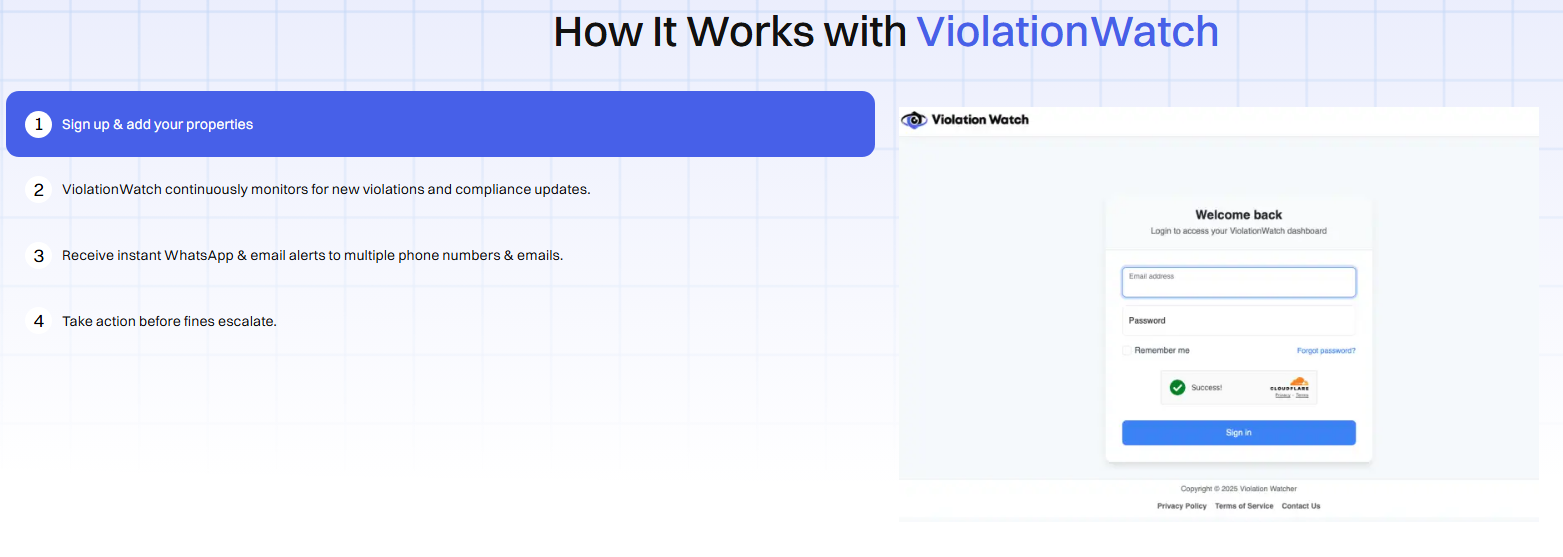
Plug in each address or BBL number. ViolationWatch instantly starts scanning city records—so you can monitor every property subject to DOHMH or OATH regulations.
2. Get instant, multi-channel alerts
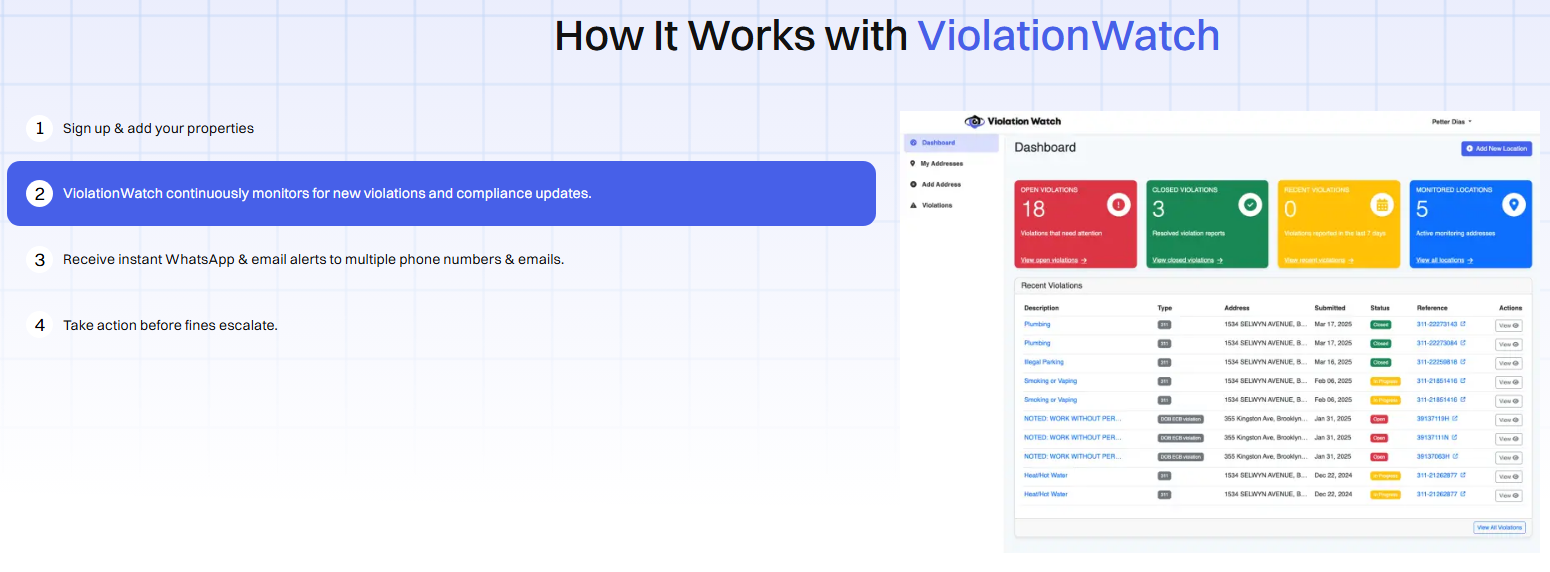
WhatsApp and email alerts are sent the moment a violation is observed or updated. Alerts go to every relevant individual, not just a single supervisor, so nothing slips through.
3. Assign and track tasks seamlessly
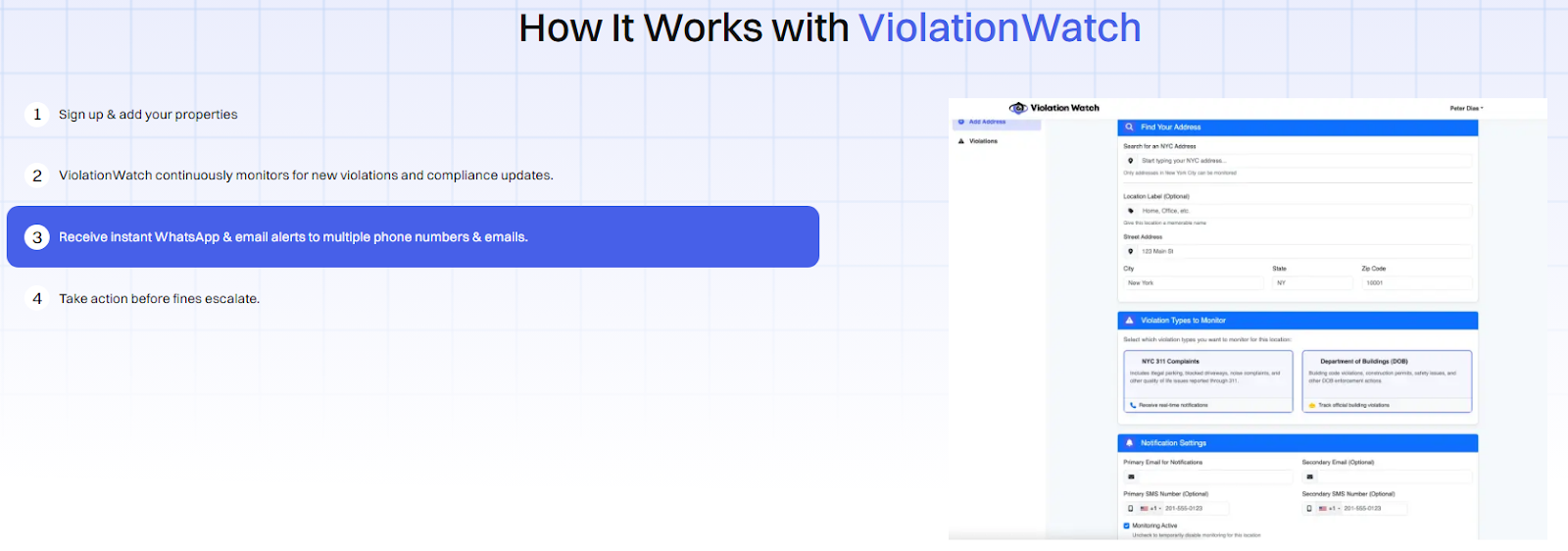
Each notice aligns with a unique workflow. Assign it to a team member, upload photos, attach documents, and update your report—all in one place.
4. Resolve with clarity

Track violations by location, agency, or priority. ViolationWatch makes it easy to see which are still open, which are resolved, and which need further steps to fully comply.
5. Stay ahead with expert support
The ViolationWatch compliance team helps you interpret requirements, correct errors, and manage filings. Whether you need help responding to an OATH hearing or prepping for mock inspections, support is built in.
Clear Pricing That Works for You
ViolationWatch offers flexible pricing for every type of operator:
- Free Trial – $0/month: Start monitoring one location with limited features and see the platform in action.
- Per Address Plan – $9.99/month per location: Unlock full access, including all alerts, unlimited locations, and full dashboard control.
No contracts. No hidden fees. You’ll receive alerts the moment new violations are posted—and take action before the city does.
Why It Feels Like Compliance Built for You
Running a kitchen means wearing multiple hats: chef, supervisor, inspector, and sometimes course corrector. But tracking multiple agencies, hearing schedules, and health inspection outcomes manually? That isn’t sustainable.
ViolationWatch was built with the operator in mind—so whether you’re conducting mock inspections, managing official hearings, or prepping for a new inspection program rollout in July, you stay ready. From tracking the smallest observed issue to building proof of compliance, this tool helps your team implement smarter systems, avoid inspection chaos, and protect your dine-in reputation with precision.
And in a city where every grade, update, and requirement matters—smart systems win. Let ViolationWatch bring peace of mind to your back-of-house before your next official inspection.
Clean Kitchen. Clean Record. No Guesswork.
You’ve now seen how minor missteps—like a misplaced utensil or a skipped glove change—can trigger costly DOHMH violations. The upside? Every one of them can be tracked, flagged, and fixed early.
Key takeaways worth locking in:
- Build hygiene habits that show up on inspection day—and every day before it.
- Sanitize by the book, not just by appearance or routine.
- Store raw, cooked, and ready-to-eat foods with clear separation and airtight labeling.
- Keep chemical use clean, labeled, and completely isolated from food zones.
If staying ahead of violations sounds like a full-time job, it’s because it used to be. Now, ViolationWatch makes it automatic. One dashboard. Instant alerts. Action before escalation. That’s how smarter kitchens stay open and inspection-ready.

